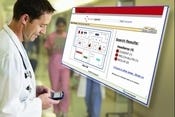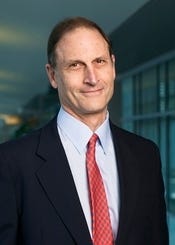Advancing IT Propelling Pediatric Surgery
Children's National Medical Center using $150 million gift from Abu Dhabi government to improve medical outcomes by using technologies like GPS and 3D graphics to customize procedures.

| |
| |
Children's National Medical Center in Washington, D.C. is on a mission to improve patient surgical outcomes through innovative new uses of information technology in pediatric surgeries.
Nearly a year ago, Children's National Medical Center received a $150 million gift from the government of Abu Dhabi to create the Sheikh Zayed Institute for Pediatric Surgical Innovation. The children's hospital has a longstanding relationship with the United Arab Emirates, caring for many UAE patients who come to the United States for treatment annually.
"We'd like to push the limits," said Dr. Nabile Safdar, a radiologist and principal investigator of the institute. The research and exploration done by the institute is aimed at not only bringing new technology-enabled tools to physicians at Children's National Medical Center, but also potentially to pediatric hospitals globally through commercialization.
The new institute is recruiting a group of about a dozen medical and technology experts -- half physicians and the remaining being IT and bio-engineers -- to explore and advance how IT is applied to the practice of pediatric surgery so that operations are more personalized for each patient, in the aim of improving outcomes.
Technologies being investigated include simulation and graphics processing technologies similar to those used in video gaming; GPS or other navigation technologies; and integrated communication systems.
Among the goals are to see how these and other advanced technologies can be applied to shorten surgeries and reduce the time young patients need to spend under anesthesia in the operating room; help surgeons in the accuracy of sensitive and complex surgeries; reduce complications and pain; and get kids healthy and home to their families sooner, Safdar said.
The institute is taking a multi-prong approach that will include having its research work published, as well as having its researchers partner with others. That could include third-party vendors of technologies used in other sectors, and innovations that have been used in the care of adults, but not young patients. The center is investigating ways that existing commercial solutions can be tailored for use in pediatric surgery. For instance, interactive navigation systems and graphic simulation have the potential for use in pediatric surgeries "for repairing the tiniest of spleens or spines, where there's less threshold for error," he said.
While video gaming gives teenagers the feeling of being immersed in a 3D world of complex landscapes and allows them to communicate in real time, those same types of technologies can be applied for simulated training and preparation of surgeons doing delicate operations on kids, such as spine surgery to correct scoliosis, curvature of the spine.
"In most cases, in 2010 we prepare the same way for surgery as 30 to 40 years ago," Safdar said. That means surgeons rely on 2D X-rays to prepare and plan for many procedures, rather than 3D views of the patient's organs.
"Surgeons make a plan for surgery, the types of tools that will be used," he said. But when it comes to the actual surgeries, screws that get inserted to correct scoliosis, for example, "are a few millimeters away from the spine," he said.
| |
| |
But the use of medical imaging technologies such as low-radiation CT scans combined with special algorithms can be used to get "dynamic 3D representations of the spine ahead of time, so that there's much less guesswork in surgery," he said.
"People with different backgrounds and expertise could build algorithms to look at the CT scans of scoliosis patients, to see the turn of the spine," he said, providing surgeons with more visual and other information than is currently available about individual patients.
Also, the application of technology that provides real-time displays on a screen of the patient's spine during the actual surgery could also help surgeons know "where their surgical tools line up to the target," such as the insertion of screws, he said.
"We tend to think of surgery as what goes on in the operating room," Safdar said. "But surgery is a round trip that starts and ends with the patient," he said. That includes multiple visits to doctors, specialists, labs, and other testing facilities to make diagnosis and plans for surgery.
"Along the way, a lot of technology isn't leveraged at all," he said. That includes the bringing together of information that comes from lab tests, medical images, electronic health records (EHRs), and other sources.
"It's much easier for a patient to schedule an international flight than a CT scan," he said, because of the delays in information getting where it needs to be and having it communicated to those who need it.
"Many EHRs aren't even indexed," he said. Even though information like a patient's allergies might be contained in an EHR, unless you know where to look for allergies, clinicians often can't find the information quickly. "Different [clinical] teams document information in different ways," even in EHRs, he said.
"Many [users of EHRs] are not using basic tools like indexing," he said. "The holy grail in surgery is to take advantage of the entirety of information that's available about a patient," he said. But that's not done today, he said. Doing so can help surgeons provide more personalized care to patients, helping improve outcomes, including faster recoveries and fewer complications.
Another aim of the institute is to develop or improve asynchronous real-time communication so that clinicians and other medical experts can better collaborate and share information in real-time, rather than rely on phone tag or e-mail, he said. Instant messaging isn't used in healthcare because it's not secure enough for exchanging patient's medical information. New developments in presence technologies could bolster communication among clinicians during patient procedures, he said.
As for the team of bioengineers, technologists, and clinicians being assembled for the institute, "our goal is to work in the same location, share expertise," so that care and outcomes are improved not only for children treated at Children's National Medical Center, "but for all children," he said.
About the Author(s)
You May Also Like
How to Amplify DevOps with DevSecOps
May 22, 2024Generative AI: Use Cases and Risks in 2024
May 29, 2024Smart Service Management
June 4, 2024










